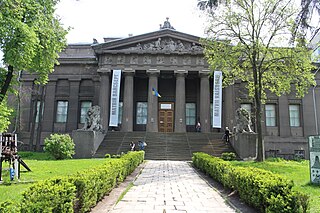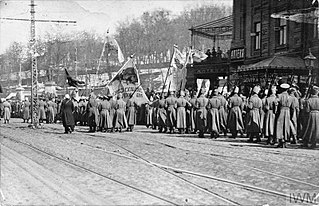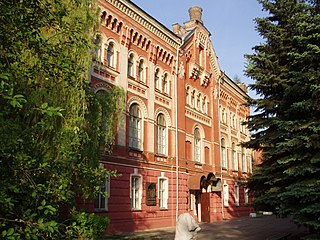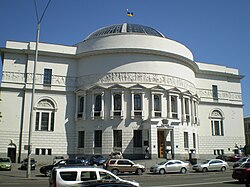
The Central Rada of Ukraine, also called the Central Council, was the All-Ukrainian council that united deputies of soldiers, workers, and peasants deputies as well as few members of political, public, cultural and professional organizations of the Ukrainian People's Republic. After the All-Ukrainian National Congress, the Council became the revolutionary parliament in the interbellum lasting until the Ukrainian-Soviet War. Unlike with many other councils in the Russian Republic, Bolshevization of the Rada failed completely, prompting the Ukrainian Bolsheviks to form a rival government in Kharkov.

The Kyiv Opera group in Ukraine was formally established in the summer of 1867, and is the third oldest opera in Ukraine, after Odesa Opera and Lviv Opera.

The National Academy of Sciences of Ukraine is a self-governing state-funded organization in Ukraine that is the main center of development of science and technology by coordinating a system of research institutes in the country. It is the main research oriented organization along with the five other academies in Ukraine specialized in various scientific disciplines. NAS Ukraine consists of numerous departments, sections, research institutes, scientific centers and various other supporting scientific organizations.

Kyiv Polytechnic Institute is a public technological university in Kyiv, Ukraine.

House with Chimaeras or Horodetsky House is an Art Nouveau building located in the historic Lypky neighborhood of Kyiv, the capital of Ukraine. Situated across the street from the President of Ukraine's office at No. 10, Bankova Street, the building has been used as a presidential residence for official and diplomatic ceremonies since 2005. The street in front of the building is closed off to all automobile traffic, and is now a patrolled pedestrian zone due to its proximity to the Presidential Administration building.

Kyiv National Ivan Karpovych Karpenko-Karyi Theatre, Cinema and Television University is the national university specializing exclusively in performing arts and located in Kyiv, Ukraine. It is a multidisciplinary institution that includes a department of theatrical arts and the Institute of Screen Arts. The university has four campuses around the city of Kyiv and a separate student dormitory. The acting rector of the university is Inna Kocharian.

The Military Institute of Telecommunication and Information Technologies named after the Heroes of Kruty is an institution of higher military education in Ukraine and part of the State University of Telecommunications, located in Pechersk neighborhood of Kyiv. In the Soviet times it was known as the Kyiv Military Engineering College of Signal.
The Ukrainian Club is a social organization that was created in Kyiv in 1908. It was closed in 1912, but revived in 2002.

The National Art Museum of Ukraine is a museum dedicated to Ukrainian art in Kyiv, Ukraine.

The Vernadsky National Library of Ukraine, VNLU is the main academic library and main scientific information centre in Ukraine, one of the world's largest national libraries. Its main building is located in the capital of the country—Kyiv, in the Demiivka neighborhood.

The Polubotok Club Affair was an important national civil affair and an armed revolt of the Kiev garrison troops that took place on July 17–18, 1917 in Kiev soon after the collapse of the Kerensky Offensive. It was part of a Ukrainian military movement, one of key roles played by the public organization Ukrainian Military Club of Pavlo Polubotok.

House of Football is a headquarters of the Football Federation of Ukraine located in Kyiv, Ukraine, right next to the Olympiyskiy National Sports Complex.
Regional Committee in Protection of Revolution in Ukraine was a short lived revolutionary organization preceding the Kiev revolutionary committee of Bolsheviks. It declared itself the supreme authority in Ukraine after the October Revolution. The committee was created on the night November 7-8, 1917 at the closed door session of the Executive Committee of Central Council of Ukraine with representatives of revolutionary organizations of Ukraine. It was dissolved in couple of days and transferred its authority of the General Secretariat of Ukraine.

The Ukrainian People's Republic (UPR) was a short-lived state in Eastern Europe. Prior to its proclamation, the Central Council of Ukraine was elected in March 1917 as a result of the February Revolution, and in June, it declared Ukrainian autonomy within Russia. Its autonomy was later recognized by the Russian Provisional Government. Following the October Revolution, the Central Council of Ukraine denounced the Bolshevik seizure of power and proclaimed the Ukrainian People's Republic with a territory including the area of approximately eight Russian imperial governorates. It formally declared its independence from Russia on 22 January 1918.

The National Academy of Visual Arts and Architecture is an art university in Kyiv, Ukraine specialising in visual arts and architecture. It has departments of painting, sculpture, illustration, graphic design, stage design, architecture, art conservation, art management.

Volodymyrska Street is a street in the center of Kyiv, the capital of Ukraine, which is named after the prince of Kievan Rus' Vladimir the Great and which is one of the oldest streets in the city, and arguably among the oldest constantly inhabited residential street in Europe. There are many educational, culture and government institutions on this street, as well as historical monuments. Four buildings from Volodymyrska Street are depicted on reverses of Ukrainian hryvnia banknotes.

The Slovo Building is a residential, multi-story building in the Shevchenkivskyi district of Kharkiv. The shape of the building reflects the letter C or S in the Ukrainian language, the first letter of слово ("slovo") or "word". The shape of the building symbolized its construction to house prominent Ukrainian writers, who lived there in over sixty apartments. Built in the late 1920s, it accommodated Ukrainian writers and poets, many of whom were later shot by the Communist authorities at Sandarmokh in Karelia. Today they are known as the "Executed Renaissance".

Mykola Ivanovych Velychkivsky was a Ukrainian economist, professor, and politician who served as chairman of the Ukrainian National Council.

The Mykola Lysenko House-Museum is one of the museums of outstanding figures of Ukrainian culture in Kyiv. It is located in the house of the teacher Mykola Gvozdik, where the Ukrainian composer Mykola Lysenko rented the 2nd floor from August 1894 to November 1912.

The 1918 Ukrainian coup d'état or Hetman Coup was a military coup d'état within the Ukrainian People's Republic on 29 April 1918. That day, farmers and landowners loyal to the Ukrainian lieutenant general Pavlo Skoropadskyi, with the support of the German Empire, launched a coup d'état against the government of the Ukrainian People's Republic, removing the Central Rada and installing Skoropadskyi as hetman.





















